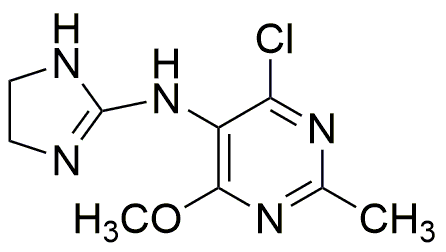Moxonidine is widely utilized in research focused on:
- Hypertension Treatment: This compound is primarily used as an antihypertensive medication, helping to lower blood pressure in patients with hypertension, which is crucial for reducing the risk of heart disease and stroke.
- Neurological Research: Moxonidine has shown potential in studies related to neuroprotection, making it a candidate for research on neurodegenerative diseases like Alzheimer's, where it may help in managing symptoms.
- Cardiovascular Studies: It is often investigated for its effects on heart rate and vascular resistance, providing valuable insights for researchers studying cardiovascular health and treatments.
- Pharmacological Comparisons: Moxonidine is used in comparative studies with other antihypertensives, allowing researchers to evaluate its efficacy and side effects against similar compounds, which can lead to better treatment options.
- Patient Compliance Research: Its unique mechanism of action may improve patient adherence to treatment regimens, making it a subject of interest in studies aimed at enhancing compliance in hypertensive patients.
General Information
Properties
Safety and Regulations
Applications
Moxonidine is widely utilized in research focused on:
- Hypertension Treatment: This compound is primarily used as an antihypertensive medication, helping to lower blood pressure in patients with hypertension, which is crucial for reducing the risk of heart disease and stroke.
- Neurological Research: Moxonidine has shown potential in studies related to neuroprotection, making it a candidate for research on neurodegenerative diseases like Alzheimer's, where it may help in managing symptoms.
- Cardiovascular Studies: It is often investigated for its effects on heart rate and vascular resistance, providing valuable insights for researchers studying cardiovascular health and treatments.
- Pharmacological Comparisons: Moxonidine is used in comparative studies with other antihypertensives, allowing researchers to evaluate its efficacy and side effects against similar compounds, which can lead to better treatment options.
- Patient Compliance Research: Its unique mechanism of action may improve patient adherence to treatment regimens, making it a subject of interest in studies aimed at enhancing compliance in hypertensive patients.
Documents
Safety Data Sheets (SDS)
The SDS provides comprehensive safety information on handling, storage, and disposal of the product.
Product Specification (PS)
The PS provides a comprehensive breakdown of the product’s properties, including chemical composition, physical state, purity, and storage requirements. It also details acceptable quality ranges and the product's intended applications.
Certificates of Analysis (COA)
Search for Certificates of Analysis (COA) by entering the products Lot Number. Lot and Batch Numbers can be found on a product’s label following the words ‘Lot’ or ‘Batch’.
*Catalog Number
*Lot Number
Certificates Of Origin (COO)
This COO confirms the country where the product was manufactured, and also details the materials and components used in it and whether it is derived from natural, synthetic, or other specific sources. This certificate may be required for customs, trade, and regulatory compliance.
*Catalog Number
*Lot Number
Safety Data Sheets (SDS)
The SDS provides comprehensive safety information on handling, storage, and disposal of the product.
DownloadProduct Specification (PS)
The PS provides a comprehensive breakdown of the product’s properties, including chemical composition, physical state, purity, and storage requirements. It also details acceptable quality ranges and the product's intended applications.
DownloadCertificates of Analysis (COA)
Search for Certificates of Analysis (COA) by entering the products Lot Number. Lot and Batch Numbers can be found on a product’s label following the words ‘Lot’ or ‘Batch’.
*Catalog Number
*Lot Number
Certificates Of Origin (COO)
This COO confirms the country where the product was manufactured, and also details the materials and components used in it and whether it is derived from natural, synthetic, or other specific sources. This certificate may be required for customs, trade, and regulatory compliance.


